NVIDIA’s GeForce GTX 480 and GTX 470: 6 Months Late, Was It Worth the Wait?
by Ryan Smith on March 26, 2010 7:00 PM EST- Posted in
- GPUs
Compute
Update 3/30/2010: After hearing word after the launch that NVIDIA has artificially capped the GTX 400 series' double precision (FP64) performance, we asked NVIDIA for confirmation. NVIDIA has confirmed it - the GTX 400 series' FP64 performance is capped at 1/8th (12.5%) of its FP32 performance, as opposed to what the hardware natively can do of 1/2 (50%) FP32. This is a market segmentation choice - Tesla of course will not be handicapped in this manner. All of our compute benchmarks are FP32 based, so they remain unaffected by this cap.
Continuing at our look at compute performance, we’re moving on to more generalized compute tasks. GPGPU has long been heralded as the next big thing for GPUs, as in the right hands at the right task they will be much faster than a CPU would be. Fermi in turn is a serious bet on GPGPU/HPC use of the GPU, as a number of architectural tweaks went in to Fermi to get the most out of it as a compute platform. The GTX 480 in turn may be targeted as a gaming product, but it has the capability to be a GPGPU powerhouse when given the right task.
The downside to GPGPU use however is that a great deal of GPGPU applications are specialized number-crunching programs for business use. The consumer side of GPGPU continues to be underrepresented, both due to a lack of obvious, high-profile tasks that would be well-suited for GPGPU use, and due to fragmentation in the marketplace due to competing APIs. OpenCL and DirectCompute will slowly solve the API issue, but there is still the matter of getting consumer orientated GPGPU applications out in the first place.
With the introduction of OpenCL last year, we were hoping by the time Fermi was launched that we would see some suitable consumer applications that would help us evaluate the compute capabilities of both AMD and NVIDIA’s cards. That has yet to come to pass, so at this point we’re basically left with synthetic benchmarks for doing cross-GPU comparisons. With that in mind we’ve run a couple of different things, but the results should be taken with a grain of salt as they don’t represent any single truth about compute performance on NVIDIA or AMD’s cards.
Out of our two OpenCL benchmarks, we’ll start with an OpenCL implementation of an N-Queens solver from PCChen of Beyond3D. This benchmark uses OpenCL to find the number of solutions for the N-Queens problem for a board of a given size, with a time measured in seconds. For this test we use a 17x17 board, and measure the time it takes to generate all of the solutions.
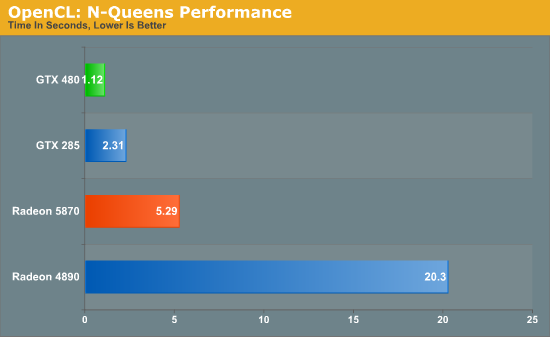
This benchmark offers a distinct advantage to NVIDIA GPUs, with the GTX cards not only beating their AMD counterparts, but the GTX 285 also beating the Radeon 5870. Due to the significant underlying differences of AMD and NVIDIA’s shaders, even with a common API like OpenCL the nature of the algorithm still plays a big part in the performance of the resulting code, so that may be what we’re seeing here. In any case, the GTX 480 is the fastest of the GPUs by far, beating out the GTX 285 by over half the time, and coming in nearly 5 times faster than the Radeon 5870.
Our second OpenCL benchmark is a post-processing benchmark from the GPU Caps Viewer utility. Here a torus is drawn using OpenGL, and then an OpenCL shader is used to apply post-processing to the image. Here we measure the framerate of the process.
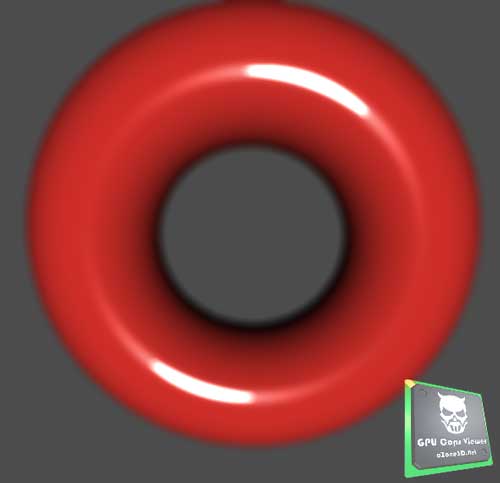
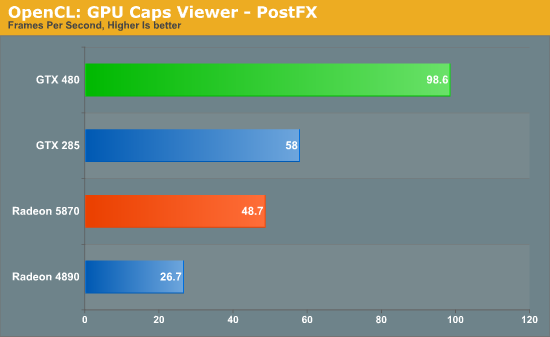
Once again the NVIDIA cards do exceptionally well here. The GTX 480 is the clear winner, while even the GTX 285 beats out both Radeon cards. This could once again be the nature of the algorithm, or it could be that the GeForce cards really are that much better at OpenCL processing. These results are going to be worth keeping in mind as real OpenCL applications eventually start arriving.
Moving on from cross-GPU benchmarks, we turn our attention to CUDA benchmarks. Better established than OpenCL, CUDA has several real GPGPU applications, with the limit being that we can’t bring the Radeons in to the fold here. So we can see how much faster the GTX 480 is over the GTX 285, but not how this compares to AMD’s cards.
We’ll start with Badaboom, Elemental Technologies’ GPU-accelerated video encoder for CUDA. Here we are encoding a 2 minute 1080i clip and measuring the framerate of the encoding process.
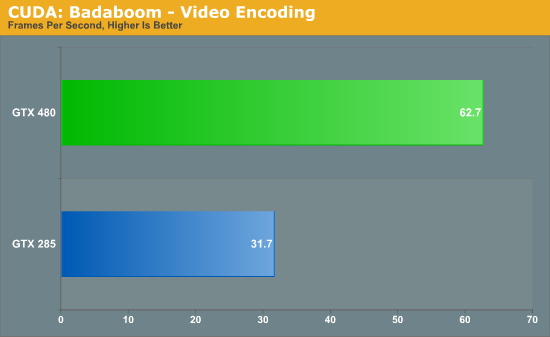
The performance difference with Badaboom is rather straightforward. We have twice the shaders running at similar clockspeeds, and as a result we get twice the performance. The GTX 480 encodes our test clip in a little over half the time it took the GTX 280.
Up next is a special benchmark version of Folding@Home that has added Fermi compatibility. Folding@Home is a Standford research project that simulates protein folding in order to better understand how misfolded proteins lead to diseases. It has been a poster child of GPGPU use, having been made available on GPUs as early as 2006 as a Close-To-Metal application for AMD’s X1K series of GPUs. Here we’re measuring the time it takes to fully process a sample work unit so that we can project how many nodes (units of work) a GPU could complete per day when running Folding@Home.
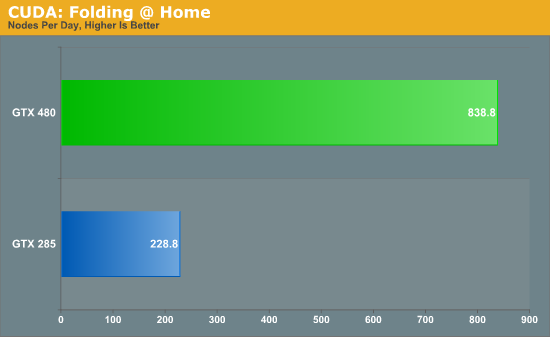
Folding@Home is the first benchmark we’ve seen that really showcases the compute potential for Fermi. Unlike everything else which has the GTX 480 running twice as fast as the GTX 285, the GTX 480 is a fewtimes faster than the GTX 285 when it comes to folding. Here a GTX 480 would get roughly 3.5x as much work done per day as a GTX 285. And while this is admittedly more of a business/science application than it is a home user application (even if it’s home users running it), it gives us a glance at what Fermi is capable when it comes to compuete.
Last, but not least for our look at compute, we have another tech demo from NVIDIA. This one is called Design Garage, and it’s a ray tracing tech demo that we first saw at CES. Ray tracing has come in to popularity as of late thanks in large part to Intel, who has been pushing the concept both as part of their CPU showcases and as part of their Larrabee project.
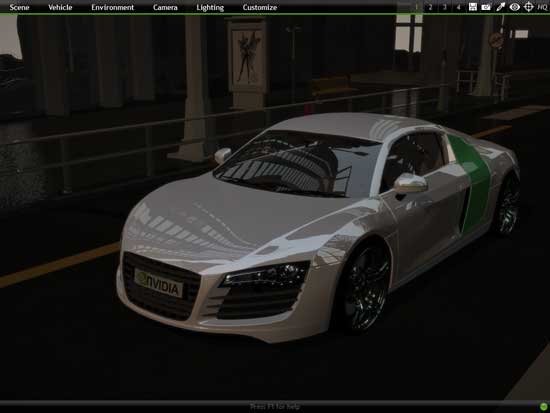
In turn, Design Garage is a GPU-powered ray tracing demo, which uses ray tracing to draw and illuminate a variety of cars. If you’ve never seen ray tracing before it looks quite good, but it’s also quite resource intensive. Even with a GTX 480, with the high quality rendering mode we only get a couple of frames per second.
On a competitive note, it’s interesting to see NVIDIA try to go after ray tracing since that has been Intel’s thing. Certainly they don’t want to let Intel run around unchecked in case ray tracing and Larrabee do take off, but at the same time it’s rasterization and not ray tracing that is Intel’s weak spot. At this point in time it wouldn’t necessarily be a good thing for NVIDIA if ray tracing suddenly took off.
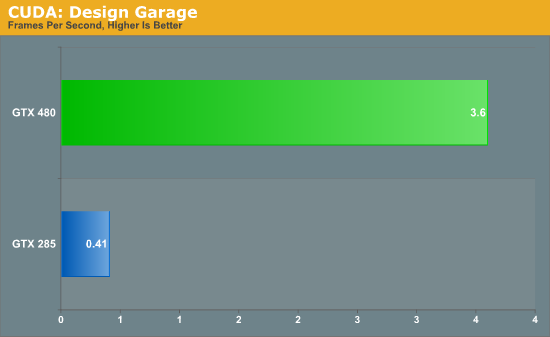
Much like the Folding@Home demo, this is one of the best compute demos for Fermi. Compared to our GTX 285, the GTX 480 is eight times faster at the task. A lot of this comes down to Fermi’s redesigned cache, as ray tracing as a high rate of cache hits which help to avoid hitting up the GPU’s main memory any more than necessary. Programs that benefit from Fermi’s optimizations to cache, concurrency, and fast task switching apparently stand to gain the most in the move from GT200 to Fermi.










196 Comments
View All Comments
deputc26 - Friday, March 26, 2010 - link
"GTX 480 only has 11% more memory bandwidth than the GTX 285, and the 15% less than the GTX 285."and holy server lag batman.
529th - Friday, March 26, 2010 - link
Thanks for the review :)ghost2code - Saturday, March 27, 2010 - link
I'm really impressed by this article author made a great job;) But about Fermi It's seem to be really good product for scientific matters but for gamers I'm not so sure about that. The price tag, power consumption, noise! this all is to much for only 10-15% of power more than above the cheaper and much more reasonable in all this things Radeon. I guess Fermi need some final touch from Nvidia and for now it's not a final , well tested product. Temp around 100 it's not good for PCB, GPU and all electronic and I don't believe it want metter for time-life and stability of the card. I'm glad the Farmi finally came but I'm dissapointed at least for now.LuxZg - Saturday, March 27, 2010 - link
I just don't know why GTX480 is compared to HD5870, and same for GTX470 vs HD5850.. GTX470 is right in the middle between two single-GPU Radeons, and just the same can be said for GTX480 sitting right in between HD5970 & HD5870.Prices of this cards as presented by nVidia/ATI:
HD5970 - 599$
GTX480 - 499$
HD5870 - 399$
GTX470 - 349$
HD5850 - 299$
I know GTX480 is single GPU, so by this logic you'll compare it to HD5870. But GTX480 is top of the line nVidia graphics card, and HD5970 is top of the line ATI card. Besides, ATI's strategy for last 3 product cycles is producing small(er) chips and go multi-GPU, while nVidia wants to go single-monolitic-GPU way.. So following this logic, indeed GTX480 should be compared to HD5970 rather than HD5870.
Anyway, conclusion of this article is all fine, telling both strengths and the weaknesses of solutions from both camps, but I believe readers weren't told straightforward enough that these cards don't cost the same... And HD5970 was left out of the most of the comparisions (textual ones).
If I personaly look at these cards, they are all worth their money. nVidia cards are probably more future-proof with their commitment to future tech (tessellation, GPGPU) but AMD cards are better for older and current (and close future) titles. And they are less hot, and less noisy, which most gamers do pay a lot of attention to. Not to say - this is first review of new card in which no one mentioned GPU overclocking. I'm guessing that 90+C temperatures won't allow much better clocks in the near future ;)
Wwhat - Sunday, March 28, 2010 - link
In regards to the temperature and noise: there's always watercooling to go to, I mean if you have so much money to throw at the latest card you might as well thrown in some watercooling too.It's too pricey for me though, I guess I'll wait for the 40nm process to be tweaked, spending so much money on a gfx card is silly if you know a while later something new will come around that's way better, and it's just not worth committing so much money to it in my view.
It's a good card though (when watercooled), nice stuff in it and faster on all fronts, but it also seems an early sample of new roads nvidia went into and I expect they will have much improved stuff later on (if still in business)
LuxZg - Tuesday, March 30, 2010 - link
Like I've said before - if you want FASTEST (and that's usually what you want if you have money to throw away), you'll be buying HD5970. Or you'll be buying HD5970+water cooling as well..ViRGE - Saturday, March 27, 2010 - link
I'm not sure where you're getting that the HD5970 is a $600 card. In the US at least, that's a $700 card (or more) everywhere.wicko - Sunday, March 28, 2010 - link
Honestly I don't even know if it should be mentioned at all even if it is 600, because there is almost no stock anywhere.LuxZg - Tuesday, March 30, 2010 - link
Oh, don't make me laugh, please! :D In that case this review shouldn't be up at all, or it should be called "PREview".. or have you actually seen any stock of GTX470/480 arround?LuxZg - Sunday, March 28, 2010 - link
It's AMD's & nVidia's recommended prices, and you can see them all in Anandtech's own articles:http://www.anandtech.com/video/showdoc.aspx?i=3783">http://www.anandtech.com/video/showdoc.aspx?i=3783 (nvidia prices)
http://www.anandtech.com/video/showdoc.aspx?i=3746">http://www.anandtech.com/video/showdoc.aspx?i=3746 (ATI single-gpu cards)
http://www.anandtech.com/video/showdoc.aspx?i=3679">http://www.anandtech.com/video/showdoc.aspx?i=3679 (ATI single/dual GPU cards)
It is not my fault that your US shops bumped up the price in the complete absence of competition in the high end market. But US is not only market in the world either.
You want to compare with real world prices? Here, prices from Croatia, Europe..
HD5970 - 4290kn = 591€ (recommended is 599$, which is usually 599€ in EU)
GTX480 - not listed, recommended is 499$/€
HD5870 - 2530kn = 348€ (recommended is 399$/399€ in EU)
GTX470 - not listed, recommended is 349$/€
HD5850 - 1867kn = 257€ (recommended is 299$/299€ in EU)
So let's say that European prices for GTX will be a bit lower than recommended ones, GTX480 would still be ~120-130€ pricier than HD5870, and HD5970 would be same ~120-130€ more expensive than GTX480.
As for the lower priced nVidia card, it's again firmly in the middle between HD5850 & HD5870.
Point is that there's no clear price comparision at the moment, and article's conclusion should be clear on that.
Person that wants the FASTEST CARD will stretch for another 100$/€ to buy HD5970. Especially since this means lower noise, lower consumption, and lower heat. This all combined means you can save a few $/€ on PSU, case, cooling, and earplugs, throwing HD5970 in the arm reach of the GTX480 (price-wise) while allowing for better speeds.
As for GTX470, again, lower consumption/heat/noise with ATI cards which means less expenses for PSU/cooling, and saving money on electrical bills. For me, well worth the 50€/$ difference in price, in fact, I'd rather spend 50$/€ more to buy HD5870 which is faster, less noisy, doesn't require me to buy new PSU (I own HD4890, which was overclocked for a while, so HD5870 would work fine just as well), and will save me 50W per hour of any game I play.. which will all make it CHEAPER than GTX470 in the long run.
So let's talk again - why isn't conclusion made a bit more straightforward for end users, and why is HD5890 completely gone from the conclusion??